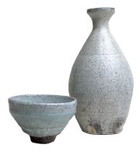
|
Tradition Lives On: Souvenirs from Kyoto
Have you ever thought of visiting Kyoto, Japan's ancient capital? If you have a chance to go there, here are some of the things you may want to buy.The city's craftwork traditions go back more than a thousand years. In Kyoto, there are many things that will bring you closer to the distant past.
Written by Fukushima Emi, Photos by Takeda Norihisa
|
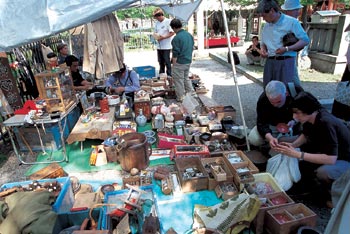 |
 |
Most of the booths at the Kobo-ichi market sell antiques or second-hand objects. The market is a great place for bargain hunting, and haggling over the price can be fun, too.
|
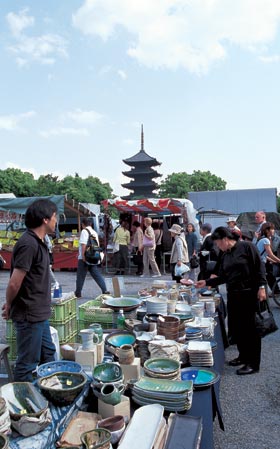
The Kobo-ichi Market is held on the 21st of each month within the grounds of To-ji Temple, 15 on map, and always attracts a
big crowd. The photo shows a few of the tables selling pottery.
The five-storied pagoda in the background (55 meters high) is a symbol of Kyoto.

|
The true spirit of Japanese traditional craftwork lives on in Kyoto. Chosen as the country's capital about 1,200 years ago, Kyoto became home to various types of artisans, who developed special techniques and continued to improve on them, generation after generation.
One traditional industry that comes to mind is Nishijin-ori weaving (making elegant silk fabrics that often have an ornate pattern). Silk weaving was a sought-after art, beginning in ancient times. After Kyoto became the nation's capital, the court commissioned workshops to weave cloth for the palace and aristocrats. But wars in the middle ages destroyed the industry. Weaving picked up again in the 16th century. The military gentry and business class developed a taste for gorgeous silk cloth decorated with threads of gold and silver, and this was the beginning of Nishijin-ori weaving. Today, you can buy Nishijin fabric made into neckties, kimono, obi waistbands for kimono, and more.
The city has many Buddhist temples, so it is natural that artisans there became very skillful in making temple accessories and butsudan (cabinets containing a Buddhist image and family mortuary tablets). The various arts of carving and working with materials like wood, lacquer and gold leaf all combined to produce religious objects that are the finest in Japan.
Folding fans first appeared in Kyoto in the mid-9th century, and soon the court aristocrats considered them an essential part of their costume. The fans later spread to other classes as well, and became props for mai dancers and Noh actors. They were also necessary accessories at a tea ceremony. They made hot summer days a little cooler, and were sometimes decorated with scenes of nature, then used also as ornamental items.
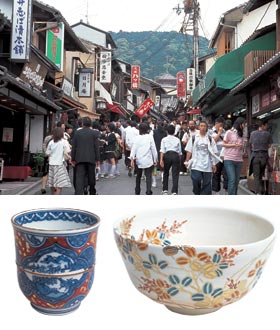
Above: Many shops sell Kiyomizu ware ceramics on two sloped streets called Kiyomizu-zaka and Gojo-zaka, near Kiyomizu-dera Temple.
The item on the left is a Kiyomizu ware teacup (38,000 yen), and on the right, a tea bowl used for drinking a powdered green tea called matcha. (30,000 yen)
Nipponia thanks the following for their collaboration: Kyoto Ceramic Center

|
Many other handicrafts also developed during Kyoto's long history. Beautiful Kyo kumi-himo braided cord is used to make stylish objects such as obi-jime fasteners for obi waistbands. And then there are elegant Kyo yaki ceramics (such as Kiyomizu ware), lacquer ware, Kyo karakami printed paper with marvelous colors, finely dyed yuzen cloth, Kyo uchiwa flat fans, bamboo work, Kyoto dolls… the list goes on and on.
When shopping for this type of souvenir, the best place to start looking may be a workshop that makes them, or a specialty shop. Some stores were established several hundred years ago, and the old construction methods and the unique wrapping paper will take you into the past. Of course, an easy way to shop is to visit a department store or specialty shop, and you will find many in the shopping districts of Shijo Kawara-machi and Shin Kyogoku. Or you could go to a souvenir shop near a famous temple—perhaps Kiyomizu-dera or Kinkaku-ji—or to some other tourist spot, like Kyoto Studio Park or the Arashiyama district. These places have fine souvenirs that will always remind you of Kyoto.
If you are an expert souvenir hunter, go and look for quality at a reasonable price at the Kobo-ichi antique market. On the 21st of each month, everything from ceramic and lacquer ware to old furniture, used clothing and kimono remnants is displayed within the grounds of To-ji Temple, which is famous for its five-storied pagoda. Goods are laid out in more than 1,200 booths, and stalls selling food add to the festive atmosphere. The place is crowded with window shoppers and tourists from early morning to evening.
Nishiki Ichiba Market offers so many food options that it is called the kitchen storehouse of Kyoto. About 130 stores stand side by side on a 390-meter stretch of street running east-west, displaying tempting food like fresh fish, fruit and vegetables, cooked side dishes, tea and pickles, as well as kitchen utensils like knives and pots. Among all of this vast selection you will find specialties this city is famous for—fresh vegetables unique to the region, pickles salted and seasoned using a local recipe, tofu, yuba (a delicious, thin soy membrane that forms when simmering soymilk), and fu (made by kneading wheat flour to obtain the protein-rich gluten).
Every trip to Kyoto is a voyage into a world of beautiful objects rich in tradition. With all this variety, the choice is up to you.


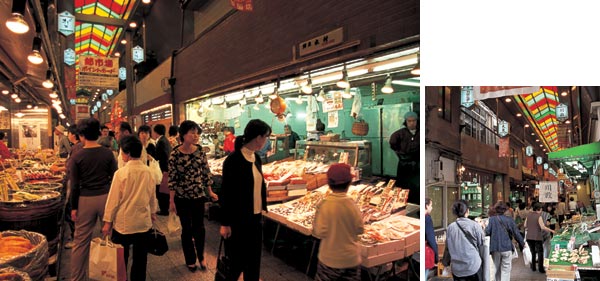 |
The Nishiki Ichiba Market, 19 on map, offers a wide variety of food products, many of them typical of Kyoto. Open generally from around 9 a.m. to 5 p.m. Many stalls are closed every Wednesday and Sunday. 
|




